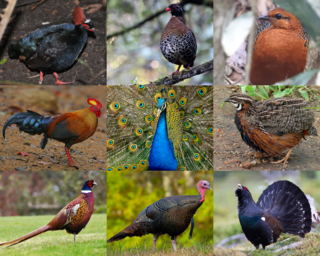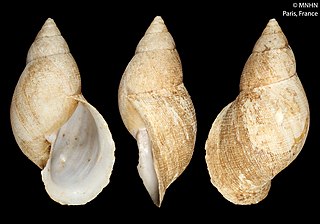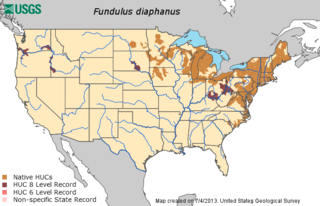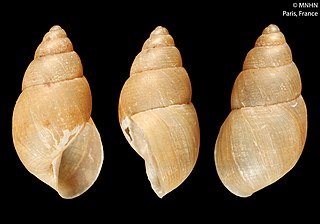
The Phasianidae are a family of heavy, ground-living birds, which includes pheasants, partridges, junglefowl, chickens, turkeys, Old World quail, and peafowl. The family includes many of the most popular gamebirds. The family includes 185 species divided into 54 genera. It was formerly broken up into two subfamilies, the Phasianinae and the Perdicinae. However, this treatment is now known to be paraphyletic and polyphyletic, respectively, and more recent evidence supports breaking it up into two subfamilies: Rollulinae and Phasianinae, with the latter containing multiple tribes within two clades. The New World quail (Odontophoridae) and guineafowl (Numididae) were formerly sometimes included in this family, but are now typically placed in families of their own; conversely, grouse and turkeys, formerly often treated as distinct families, are now known to be deeply nested within Phasianidae, so they are now included in the present family.

Littorina is a genus of small sea snails, marine gastropod molluscs in the family Littorinidae, the winkles or periwinkles.

Fundulus is a genus of ray-finned fishes in the superfamily Funduloidea, family Fundulidae. It belongs to the order of toothcarps (Cyprinodontiformes), and therein the large suborder Cyprinodontoidei. Most of its closest living relatives are egg-laying, with the notable exception of the splitfin livebearers (Goodeidae).

Bulimulus is a genus of small to medium-sized tropical or sub-tropical, air-breathing land snails, pulmonate gastropod mollusks in the subfamily Bulimulinae within the family Bulimulidae.

The banded killifish is a North American species of temperate freshwater killifish belonging to the genus Fundulus of the family Fundulidae. Its natural geographic range extends from Newfoundland to South Carolina, and west to Minnesota, including the Great Lakes drainages. This species is the only freshwater killifish found in the northeastern United States. While it is primarily a freshwater species, it can occasionally be found in brackish water.

Lymnaea is a genus of small to large-sized air-breathing freshwater snails, aquatic pulmonate gastropod mollusks in the subfamily Lymnaeinae ( of the family Lymnaeidae, the pond snails.
Ammoglanis is a genus of pencil catfishes native to South America.
Hyperolius diaphanus is a species of frog in the family Hyperoliidae. It is endemic to the eastern Democratic Republic of the Congo and is known from near the Itombwe Mountains and the mountains to the west of Lake Kivu. Limits of its range are not clear and might extend into the adjacent Burundi and Rwanda. Common names Kigulube reed frog and translucent reed frog have been proposed for this species.

Margarites is a genus of sea snails, marine gastropod mollusks in the family Margaritidae.

Tanymastix stagnalis is a species of Anostraca that lives in temporary pools across Europe. It may reach up to 2 cm (0.8 in) in some areas and has 11 pairs of bristly, flattened appendages. It swims upside-down and filters food particles from the water. It is the only species of Anostraca in Ireland, having been discovered in Rahasane Turlough in 1974.

Chirocephalus diaphanus is a widely distributed European species of fairy shrimp that lives as far north as Great Britain, where it is the only surviving species of fairy shrimp and is protected under the Wildlife and Countryside Act 1981. It is a translucent animal, about 0.5 in (13 mm) long, with reddened tips to the abdomen and appendages. The body comprises a head, a thorax bearing 11 pairs of appendages, and a seven-segmented abdomen. In males, the antennae are enlarged to form "frontal appendages", while females have an egg pouch at the end of the thorax.

Argobuccinum is a genus of predatory sea snails, marine gastropod mollusks in the family Cymatiidae.

Bulimulus diaphanus is a species of tropical air-breathing land snail, a pulmonate gastropod mollusk in the subfamily Bulimulinae.
Laevapex is a genus of small, freshwater, air-breathing limpets, aquatic pulmonate gastropod molluscs in the family Planorbidae, the ram's horn snails and their allies.

Greta diaphanus, the Antillean clearwing, is a species of clearwing (ithomiine) butterflies, named by Dru Drury in 1773.

Whittlesford - Thriplow Hummocky Fields is a 55.6-hectare (137-acre) biological Site of Special Scientific Interest between Whittlesford and Thriplow in Cambridgeshire. This site has two unusual species, the nationally rare grass-poly, which is only found in south Cambridgeshire on the British mainland, and the nationally uncommon fairy shrimp Chirocephalus diaphanus. They are found in shallow hollows in arable fields, which are the result of ice lenses melting at the end of the last ice age. There are also uncommon liverworts.

Blepharidopterus is a genus of plant bugs in the family Miridae. There are about nine described species in Blepharidopterus.
Ammoglanis diaphanus is a species of pencil catfish is found in a stream tributary to Javaés River, in the Araguaia River basin in Brazil. This species reaches a length of 1.9 cm (0.75 in).













